Rajasthani people
Rajasthani people or Rajasthanis are an Indo-Aryan ethnic group native to Rajasthan ("the land of kingdoms")[1] region of India. Their language, Rajasthani, is a part of the western group of Indo-Aryan languages.
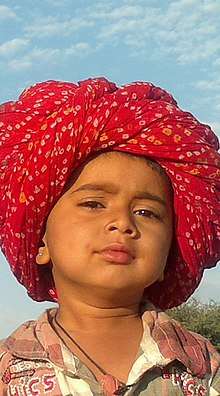 | |
| Regions with significant populations | |
|---|---|
| Rajasthan, India | |
| Languages | |
| Rajasthani and Hindi | |
| Religion | |
| Hinduism, Islam, Jainism, Sikhism, Buddhism, Christianity, Zorastrianism, Judaism, Bahá'í |
History
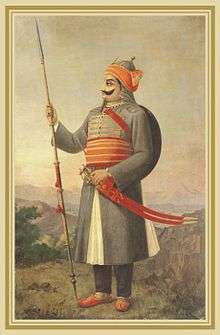
| Part of a series on |
| Rajasthani people |
|---|
| Culture |
| Religion |
|
| Language |
| Rajasthan Portal |
The first mention of word Rajasthan comes from the works of George Thomas (Military Memories) and James Tod (Annals). Rajasthan literally means a Land of Kingdoms. However, western Rajasthan with eastern Gujarat were part of "Gurjaratra" or Gurjarabhumi, land of Gurjars.[2] The local dialects of the time use the expression Rājwār, the place or land of kings, later corrupted by the British to Rajputana.[3][4]
Although history of Rajasthan goes back as far as Indus Valley Civilization, the foundation of Rajasthani community took shape with the rise of Western Middle Kingdoms such as Western Kshatrapas. Western Kshatrapas (35-405 BC) were rulers of the western part of India (Saurashtra and Malwa: modern Gujarat, Southern Sindh, Maharashtra, Rajasthan). They were successors to the Indo-Scythians who invaded the area of Ujjain and established the Saka era (with Saka calendar), marking the beginning of the long-lived Saka Western Satraps kingdom.[5] Saka calendar (also been adopted as Indian national calendar) is used by Rajasthani community and adjoining areas such as Punjab and Haryana. With time their social structures got stronger reorganizations giving birth to several martial sub ethnic groups (previously called as Martial race but now obsolete term). Rajasthanis emerged as major merchants during medieval India. Rajasthan was among the important centers of trade with Rome, eastern Mediterranean and southeast Asia.[6]
Romani people
Some claim that Romani people originated in parts of the Rajasthan. Indian origin was suggested on linguistic grounds as early as 200 years ago.[7] The roma ultimately derives from a form ḍōmba ("man living by singing and music"), attested in Classical Sanskrit.[8] Linguistic and genetic evidence indicates the Romanies originated from the Indian subcontinent, emigrating from India towards the northwest no earlier than the 11th century. Contemporary populations sometimes suggested as sharing a close relationship to the Romani are the Dom people of Central Asia and the Banjara of India.[9]
Origin
The origin of Rajasthanis has largely fallen into oblivion for there are no surviving written records from ancient times. Nonetheless, modern day Rajasthnis and their ancestors have inhabited Rajasthan since ancient times. The erstwhile state of Alwar, in north-eastern Rajasthan, is possibly the oldest kingdom in Rajasthan. Around 1500 BC, it formed a part of the Matsya territories of Viratnagar (present-day Bairat) encompassing Bharatpur, Dholpur, and Karauli.[10]
Religion
.jpg)
Rajasthani society is a blend of predominantly Hindus with sizable minorities of Muslims and Jains.
Hinduism
Shaivism and Vaishnavism is followed by majority of the people; however, Shaktism is followed in the form of Bhavani and her avatars are equally worshiped throughout Rajasthan.[11]
The Khatiks of Rajasthan worship the lord Shiva, Kali (kalika ma), Bhavani, and lord Ram as well as lord Hanuman.
Meenas of Rajasthan till date strongly follow Vedic culture which usually includes worship of Bhainroon (Shiva) and Krishna as well as the Durga.[12]
The Jats worship the Shiva, Vishnu, Sun, Moon and Bhavani (Goddess Durga).[13]
The Rajputs generally worship the Sun, Shiva, Vishnu, and Bhavani (Goddess Durga).[13]
The Gurjars worship the Sun God, God Devnarayan, Vishnu, Shiva, and Goddess Bhavani.[14][15][16] Historically, the Gurjars were Sun-worshipers and are described as devoted to the feet of the Sun-god.[16] Marathi Bhakti movement by Mahanubbavis and Virakaripanthis of Maharashtra had immense influence on the development of Rajasthani Bhakti movement.[17] Meerabai (मीराबाई) was an important figure during Rajasthani Bhakti movement.
Islam
Rajasthani Muslims are predominantly Sunnis. They are mainly Meo, Mirasi, Qaimkhani, Manganiar, Muslim Ranghar, Merat, Sindhi-Sipahi, Rath, and Pathans.[18] With the introduction of Islam, many community members converted to Islam, but still maintained many of their earlier traditions. They share lot of socio-ritual elements. Rajasthani Muslim communities, after their conversion, continued to follow pre-conversion practices (Rajasthani rituals and customs) which is not the case in other parts of the country. This exhibits the strong cultural identity of Rajasthani people as opposed to religious identity.[19] According to 2001 census, Muslim population of Rajasthan is 4,788,227, accounting for around 9% of the total population.[20]
Other Religions
Some other religions are also prevalent such as Buddhism, Christianity, Parsi religion and others.[13] Over time, there has been an increase in the number of followers of Sikh religion.[13] Though Buddhism emerged as a major religion during 321-184 BC in Mauryan Empire, it had no influence in Rajasthan for the fact that Mauryan Empire had minimal impact on Rajasthan and its culture.[21] Although Jainism is not that prevalent in Rajasthan today, Rajasthan and Gujarat areas were historically strong centres of Jainism in India.[22]
Castes and communities

Rajasthanis form an ethno-linguistic group that is distinct in its language, history, cultural and religious practices, social structure, literature, and art. However, there are many different castes and communities, with diversified traditions of their own. Major sub ethnic groups are Sirvi, Ahirs, Jats, Khatiks, Rajputs, Rabari, Gurjars, Bhils, Meenas, Brahmins, Mali Rajputs, Meghval, Chamar, Kholis, Agrawal, Jains, Kumhar, Chippa etc.[23][24][25][26]
The Khatik (खटिक/ķhâťïk) have widely distributed community in Indian Subcontinent , and each Khatik group has its own origin myth. What they have in common is that they were historically kshtriyas who were assigned to kill animals in yagas performed by kings. Also today, only khatiks has the right to kill animals during bali offerings at Hindu temples. According to their traditions, the god Brahma assigned to them a goats skin, the bark of trees and lac- so they could graze cattle, dye skins of goat, and deer; and tan hides with bark and lac. Another tradition, claims that the origin of the word Khatik has been derived from the Hindi word khat, which, means an immediate killing. They relate this to early days when they used to supply mutton to the kings of Rajasthan. While other sources claim that the word khatik is said to have originated from the Sanskrit word kathika, which means to butcher or hunter.
Rajputs (राजपूत, Rājpūts) are well-known warrior people of Rajasthan. Rajputs of Rajasthan (historically called Rājpūtāna) hold distinctive identity as opposed to Rajputs of other regions of the country. This identity is usually described as "proud Rajput tribes of Rājputāna".[27] They traced their lineage from a mythical fire atop Mt. Abu–a mountain in Rajasthan (Agni Kula or the Fire Family), the sun (Suryavanshi or the Sun Family), and the moon (Chandravanshi or the Moon Family). The Sun Family includes Sisodias of Mewar (Chittaur and Udaipur), Rathores of Jodhpur and Bikaner, and Kachwahas of Amber and Jaipur while The Moon family includes Bhattis of Jaisalmer whereas The Fire family includes Chauhans of Bundi and Kota and Solankis of Baran and Desuri . There is a tradition that in year 747 all Rajput clans were purified by sage . It is believed that Rajput tribes of Rajasthan were not Indo-Aryans until the purification.[28][29] Vaishya or Baniya (वैश्य/बनिया) are the trading communities which includes Agarwal, Khandelwal and Maheshwari. Agarwals trace their origin to Agroha, a historic town near Hisar in Haryana while Khandelwal and Maheshwari communities are said to be originated from Khandela, near Jaipur. The Vaishya/Vaish/Baniya community is known for their excellent trading techniques and business acumen. They are among the influential and prosperous communities of Rajasthan. Vaishs are also known for their society serving. A number of Schools, Colleges, Hospitals, Dharmshalas, etc are built by the Vaish Community which provide their facilities at very minimum rates to serve the society. Vaish people are strict vegetarians and many even avoid eating onion and garlic. Drinking alcohol is also strictly prohibited in Vaish Society.
Gurjars (गुर्जर, Gurjars) are well known people from Rajasthan. Historically, they were protectors of Gurjaratra.[30][31] Some scholars believe, Gurjars guarded some part of Northern India against foreign invasion until the end of tenth century and thus came to known as pratiharas (protectors).[32] Praiseful references can be found in Arab chronicles about administration and might of these Gurjars.[33]
Sain Nai mostly lives in Alwar, Dausa, Bharatpur, Jaipur & some other district of Rajasthan. They worship their kuldevi sati Narayani Mata (Temple in Alwar)
l.[34]
RABARI in Rajasthan is also known as RAIKA or DEWASI. They are Chandravanshi yadav .
Seervi are mainly in agriculture business in Jodhpur and Pali District of Rajasthan. Major population of Seervi's are followers of Aai Mata which has main temple at Bilara. These days Seervi have migrated from Rajasthan to Southern part of India and became good business community.
There are few other tribal communities in Rajasthan, such as Meena and Bhils. The Ghoomar dance is one well-known aspect of Bhil tribe. Meena and Bhils were employed as soldiers by Rajputs for their bravery and martial capabilities. Meenas, in ancient times, were ruler of Matsya, i.e., Rajasthan or Matsya Union. However, during colonial rule, the British government declared 250 groups[35] which included Meenas, Gujars, etc.[36][37] as "criminal tribes". Any group or community that took arms and opposed British rule were branded as criminal by the British government in 1871.[38] This Act was repealed in 1952 by Government of India.[35] Sahariyas, the jungle dwellers, who are believed to be of Bhil origin, inhabit the areas of Kota, Dungarpur and Sawai Madhopur in the southeast of Rajasthan. Their main occupations include working as shifting cultivators, hunters and fishermen.[39][40] Garasias is a small Rajput tribe inhabiting Abu Road area of southern Rajasthan.[39][40]
Rajasthani Brahmins are mostly dadheechs, Pareeks, Saraswats, Gujar Gaur, Khandelwal Brahmins or Khandal, Shrimalis, Garg Brahmins, Sharma Brahmins, Bhutia Brahmins, Paliwals, Pushkarna Brahmins, and Gauds. There are a few other colourful folks, groups like those of Gadia Luhar, Banjara, Nat, Kalbelia, and Saansi, who criss-cross the countryside with their animals. The Gadia Luhars are said to be once associated with Maharana Pratap.[41]
Rajasthani literature
Scholars agree on the fact that during 10th-12th century, a common language was spoken in Western Rajasthan and Northern Gujarat. This language was known as Old Gujarati (1100 AD — 1500 AD) (also called Old Western Rajasthani, Gujjar Bhakha, Maru-Gurjar). The language derived its name from the Gurjars (or Gujjars), who were residing and ruling in Punjab, Rajputana, central India, and various parts of Gujarat at that time.[42] It is said that Marwari and Gujarati has evolved from this Gurjar Bhakha later.[43] The language was used as a literary language as early as the 12th century. Poet Bhoja has referred to Gaurjar Apabhramsha in 1014 AD.[42] Formal grammar of Rajasthani was written by Jain monk and eminent scholar Hemachandra Suri in the reign of Chaulukya king Jayasimha Siddharaja. Rajasthani was recognized by the State Assembly as an official Indian language in 2004. Recognition is still pending from the government of India.[44]
First mention of Rajasthani literature comes from a well known work Kuvalayamala, inscribed c. 778 in the town of Jalor in south-eastern Marwar by Jain acharya Udyotan Suri. Udyotan Suri referred it as Maru Bhasha or Maru Vani. Modern Rajasthani literature began with the works of Suryamal Misrama.[45] His most important works are the Vamsa Bhaskara and the Vira satsaī. The Vira satsaī is a collection of couplets dealing with historical heroes. Two other important poets in this traditional style are Bakhtavara Ji and Kaviraja Muraridana. Apart from academic literature, there exists folk literature as well. Folk literature consists of ballads, songs, proverbs, folk tales, and panegyrics. The heroic and ethical poetry were the two major components of Rajasthani literature throughout its history. The development of Rajasthani literature, as well as virkavya (heroic poetry), from the Dingal language took form during the early formation of medieval social and political establishments in Rajasthan. Maharaja Chatur Singh (1879–1929) was a devotional poet from Mewar. His contributions were poetry style that was essentially a bardic tradition in nature. Another important poet was Hinglajdan Kaviya (1861–1948). His contributions are largely of the heroic poetry style.[46]
Developmental progression and growth of Rajasthani literature cand be divided into 3 stages[47]
| 900 to 1400 AD | The Early Period |
| 1400 to 1857 AD | Medieval Period |
| 1857 to present day | Modern Period |
Culture and tradition
%2C_Kishangarh%2C_ca._1750%2C_National_Museum_New_Delhi.jpg)
Dress

Traditionally men wear dhotis, kurta, angarkha and paggar or safa (kind of turban headgear). Traditional Chudidar payjama (puckered trousers) frequently replaces dhoti in different regions. Women wear ghagra (long skirt) and kanchli (top). However, dress style changes with lengths and breaths of vast Rajasthan. Dhoti is worn in different ways in Marwar (Jodhpur area) or Shekhawati (Jaipur area) or Hadoti (Bundi area). Similarly, there are a few differences pagri and safa despite both being Rajasthani headgear. Mewar has the tradition of paggar, whereas Marwar has the tradition of safa.

Rajasthan is also famous for its amazing ornaments. From ancient times, Rajasthani people have been wearing jewelry of various metals and materials. Traditionally, women wore Gems-studded gold and silver ornaments. Historically, silver or gold ornaments were used for interior decoration stitched on curtains, seat cushions, handy-crafts, etc. Wealthy Rajasthanis used Gems-studded gold and silver on swords, shields, knives, pistols, cannon, doors, thrones, etc., which reflects the importance of ornaments in lives of Rajasthanis.[48]
Cuisine
Rich Rajasthani culture reflects in the tradition of hospitality which is one of its own kind. Rajasthan region varies from arid desert districts to the greener eastern areas. Varying degree of geography has resulted in a rich cuisine involving both vegetarian and non vegetarian dishes. Rajasthani food is characterized by the use of Jowar, Bajri, legumes and lentils, its distinct aroma and flavor achieved by the blending of spices including curry leaves, tamarind, coriander, ginger, garlic, chili, pepper, cinnamon, cloves, cardamom, cumin, and rosewater.
The major crops of Rajasthan are jowar, bajra, maize, ragi, rice, wheat, barley, gram, tur, pulses, ground nut, sesamum, etc. Millets, lentils, and beans are the most basic ingredients in food.
The majority of Hindu and Jain Rajasthanis are vegetarian. Rajasthani Jains do not eat after sundown, and their food does not contain garlic and onions. Rajputs are usually meat eaters. Eating beef is and was a taboo.[49][50]
Rajasthani cuisines have a whole lot of varieties, varying regionally between the arid desert districts and the greener eastern areas. Most famous dish is Dal-Baati-Churma. It is a little bread full of clarified butter roasted over hot coals and served with a dry, flaky sweet made of gram flour, and Ker-Songri made with a desert fruit and beans.
Art

Music
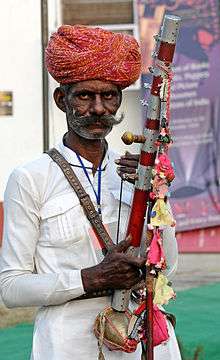
Rajasthani Music has a diverse collection of musicians. Major schools of music includes Udaipur, Jodhpur, and Jaipur. Jaipur is a major Gharanas which is well known for its reverence for rare ragas. Jaipur-Atrauli Gharana is associated with Alladiya Khan (1855–1943), who was among the great singers of the late 19th and early 20th century. Alladiya Khan was trained both in Dhrupad and Khyal styles, though his ancestors were Dhrupad singers.[51] The most distinguishing feature of Jaipur Gharana is its complex and lilting melodic form.
Rajasthani paintings
The colorful tradition of Rajasthani people reflects in art of paintings as well. This painting style is called Maru-Gurjar painting. It throws light on the royal heritage of ancient Rajasthan. Under the Royal patronage, various styles of paintings developed, cultivated, and practiced in Rajasthan, and painting styles reached their pinnacle of glory by 15th to 17th centuries. The major painting styles are phad paintings, miniature paintings, kajali paintings, gemstone paintings, etc. There is incredible diversity and imaginative creativity found in Rajasthani paintings. Major schools of art are Mewar, Marwar, Kishangarh, Bundi, Kota, Jaipur, and Alwar.

Development of Maru-Gurjar painting[52]
- Western Indian painting style - 700 AD
- Mewar Jain painting style - 1250 AD
- Blend of Sultanate Maru-Gurjar painting style - 1550 AD
- Mewar, Marwar, Dhundar, and Harothi styles - 1585 AD
Phad paintings ("Mewar-style of painting") is the most ancient Rajasthani art form. Phad paintings, essentially a scroll painting done on cloth, are beautiful specimen of the Indian cloth paintings. These have their own styles and patterns and are very popular due to their vibrant colors and historic themes. The Phad of God Devnarayan is largest among the popular Pars in Rajasthan. The painted area of God Devnarayan Ki Phad is 170 square feet (i.e. 34' x 5').[53] Some other Pars are also prevalent in Rajasthan, but being of recent origin, they are not classical in composition.[53] Another famous Par painting is Pabuji Ki Phad. Pabuji Ki Phad is painted on a 15 x 5 ft. canvas.[53] Other famous heroes of Phad paintings are Gogaji, Prithviraj Chauhan, Amar Singh Rathore, etc.[54]
Architecture
 Interior shows stone work Adisvara temple
Interior shows stone work Adisvara temple Jain temple at Ranakpur
Jain temple at Ranakpur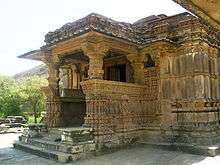 Nagda Temple
Nagda Temple Dev Somnath Temple
Dev Somnath Temple
The rich tradition of Rajasthanis also reflect in the architecture of the region. There is a connecting link between Māru-Gurjara architecture and Hoysala temple architecture. In both of these styles, architecture is treated sculpturally.[55]
Occupation
Agriculture is the main occupation of Rajasthani people in Rajasthan. Major crops of Rajasthan are jowar, bajri, maize, ragi, rice, wheat, barley, gram, tur, pulses, ground nut, sesamum, etc. Agriculture was the most important element in the economic life of the people of medieval Rajasthan.[56] In early medieval times, the land that could be irrigated by one well was called Kashavah, which is a land that could be irrigated by one Knsha or leather bucket.[57] Historically, there were a whole range of communities in Rajasthan at different stages of economy, from hunting to settled agriculture. The Van Baoria, Tirgar, Kanjar, vagri, etc. were traditionally hunters and gatherers. Now, only the Van Baoria are hunters, while others have shifted to agriculture related occupations.[58] There are a number of artisans, such as Lohar and Sikligar. Lohar are blacksmiths while Sikligar do specific work of making and polishing of arms used in war. Now, they create tools used for agriculture.
Trade and business
Historically, Rajasthani business community (famously called Marwaris, Rajasthani: मारवाड़ी) conducted business successfully throughout India and outside of India. Their business was organized around the "joint-family system", in which the grandfather, father, sons, their sons, and other family members or close relatives worked together and shared responsibilities of business work.[59] The success of Rajasthanis in business, that too outside of Rajasthan, is the outcome of feeling of oneness within the community. Rajasthanis tend to help community members, and this strengthens the kinship bondage, oneness, and trust within community. Another fact is that they have the ability to adapt to the region they migrate. They assimilate with others so well and respect the regional culture, customs, and people.[60] It is a rare and most revered quality for any successful businessman. Today, they are among the major business classes in India. The term Marwari has come to mean a canny businessman from the State of Rajasthan (and also Gujarat). The Bachhawats, Birlas, Goenkas, Bajajs, Ruias, Piramels and Singhanias are among the top business groups of India. They are the famous marwaris from Rajasthan.[61]
Diaspora
The Marwari group of Rajasthanis have a substantial diaspora throughout India, where they have been established as traders.[62] Marwari migration to the rest of India is essentially a movement in search of opportunities for trade and commerce. In most cases, Rajasthanis migrate to other places as traders.[63]
Maharashtra
In Maharashtra (an ancient Maratha Desh), Rajasthanis are mainly merchants and own large to medium size business houses. Maheshwaris are mainly Hindus (some are also Jains), who migrated from Rājputāna in the olden days. They usually worship all Gods and Goddesses along with their village deities.[64]
Images
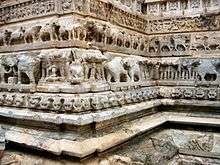 Carved elephants on the walls of Jagdish Temple that was built by Maharana Jagat Singh Ist in 1651 A.D.
Carved elephants on the walls of Jagdish Temple that was built by Maharana Jagat Singh Ist in 1651 A.D.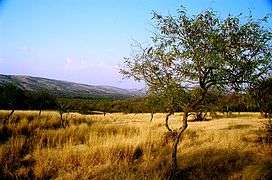 The region surrounding Aravalli hills near Ranthambore, Rajasthan, India.
The region surrounding Aravalli hills near Ranthambore, Rajasthan, India.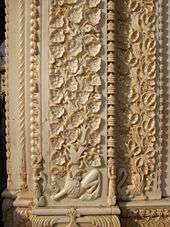 Detailed stone work, Karni Mata Temple, Bikaner Rajasthan.
Detailed stone work, Karni Mata Temple, Bikaner Rajasthan. Marble stone work, Jaisalmer Jain Temple, Rajasthan.
Marble stone work, Jaisalmer Jain Temple, Rajasthan.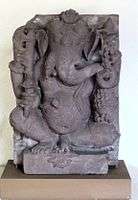 Seated Ganesha, sandstone sculpture from Rajasthan, India, 9th century, Honolulu Academy of Arts.
Seated Ganesha, sandstone sculpture from Rajasthan, India, 9th century, Honolulu Academy of Arts.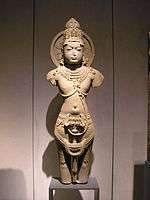 Yellow sandstone sculpture of a standing deity, 11th century CE, Rajasthan.
Yellow sandstone sculpture of a standing deity, 11th century CE, Rajasthan. Armor coat, 18th century, Rajasthan.
Armor coat, 18th century, Rajasthan.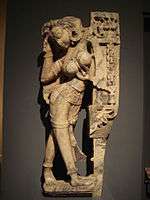 Marble sculpture of a female, ca 1450, Rajasthan.
Marble sculpture of a female, ca 1450, Rajasthan. Bani Thani painting, Rajasthan.
Bani Thani painting, Rajasthan.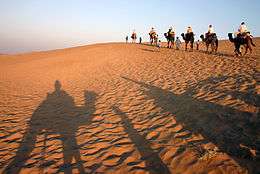 Camel ride in sand dunes, Thar desert, Jaisalmer.
Camel ride in sand dunes, Thar desert, Jaisalmer.
See also
- List of people from Rajasthan
- Art of Rajasthan
- Culture of Rajasthan
- Marwadi
- Mandore
- Mewar
- Baniya
- Meenas
- Suthar
- Kathputli (Puppet)
References
- The Territories and States of India By Tara Boland-Crewe, David Lea, pg 208
- Ramesh Chandra Majumdar; Achut Dattatrya Pusalker, A. K. Majumdar, Dilip Kumar Ghose, Vishvanath Govind Dighe, Bharatiya Vidya Bhavan (1977). The History and Culture of the Indian People: The classical age. Bharatiya Vidya Bhavan. p. 153
- R.K. Gupta; S.R. Bakshi (1 January 2008). Studies In Indian History: Rajasthan Through The Ages The Heritage Of Rajputs (Set Of 5 Vols.). Sarup & Sons. pp. 143–. ISBN 978-81-7625-841-8. Retrieved 30 October 2012.
- John Keay (2001). India: a history. Grove Press. pp. 231–232. ISBN 0-8021-3797-0.
- "The dynastic art of the Kushans, John Rosenfield, p 130
- A brief history of India By Judith E. Walsh,43
- Fraser, Angus (1 February 1995). Gypsies (Peoples of Europe) (2nd ed.). Blackwell, Oxford. ISBN 978-0-631-19605-1.
- Cf. Ralph L. Turner, A comparative dictionary of the Indo-Aryan languages, p. 314. London: Oxford University Press, 1962-6.
- Hancock, Ian (2002). Ame Sam e Rromane Džene/We are the Romani people. p. 13. ISBN 1-902806-19-0.
- /de/India/rajasthan-people-society.aspx
- The Jains By Paul Dundas, Pg 148
- Kishwar, Madhu (1994). Codified Hindu Law. Myth and Reality. Economics and political weekly,.
- "Our People". Government of Rajasthan. Archived from the original on 7 February 2008.
- Daniel Neuman; Shubha Chaudhuri; Komal Kothari (2007). Bards, ballads and boundaries: an ethnographic atlas of music traditions in West Rajasthan. Seagull. ISBN 978-1-905422-07-4.
Devnarayan is worshiped as an avatar or incarnation of Vishnu. This epic is associated with the Gujar caste
- Indian studies: past & present, Volume 11. Today & Tomorrow's Printers & Publishers. 1970. p. 385.
The Gujars of Punjab, North Gujarat and Western Rajasthan worship Sitala and Bhavani
- Lālatā Prasāda Pāṇḍeya (1971). Sun-worship in ancient India. Motilal Banarasidass. p. 245.
- The foundations of the composite culture in India By Malika Mohammada, p 257
- Muslim Communities of Rajasthan, ISBN 1-155-46883-X, 9781155468839
- Rajasthan, Volume 1 By K. S. Singh, B. K. Lavanta, Dipak Kumar Samanta, S. K. Mandal, Anthropological Survey of India, N. N. Vyas, p 19
- Indian Census 2001 – Religion Archived 12 March 2007 at the Wayback Machine
- Land and people of Indian states and union territories:Rajasthan by Gopal K. Bhargava, Shankarlal C. Bhatt, p 18
- Jainism: the world of conquerors, Volume 1 By Natubhai Shah, p 68
- "Rajasthan's castes were first classified by British - Times of India". The Times of India. Retrieved 20 January 2019.
- "In poll battle for Rajasthan, BJP fights Rajput woes". The Economic Times. 30 November 2018. Retrieved 20 January 2019.
- "Rajput population in Rajasthan - Google Search". www.google.com. Retrieved 20 January 2019.
- Serving Empire, Serving Nation by Glenn J. Ames, The University of Toledo, Pg 31
- A history of India By Hermann Kulke, Dietmar Rothermund, p 117
- Early Aryans to Swaraj By S.R. Bakshi, S.G, p 479
- R.C. Majumdar (1994). Ancient India. Motilal Banarsidass. p. 263. ISBN 978-81-208-0436-4.
- Kumar Suresh Singh; Rajendra Behari Lal; Anthropological Survey of India (2003). Gujarat, Part 1. Popular Prakashan. ISBN 978-81-7991-104-4.
- New image of Rajasthan. Directorate of Public Relations, Government of Rajasthan. 1966. p. 2.
- History of Ancient India: Earliest Times to 1000 A.D, Atlantic Publishers & Distributors, 2002, p. 207, ISBN 978-81-269-0027-5,
The king of Gurjars maintain numerous faces and no other Indian prince has so fine a cavalry.
- Jibraeil: "Position of Jats in Churu Region", The Jats - Vol. II, Ed Dr Vir Singh, Delhi, 2006, p. 223
- The Indian constitution--: a case study of backward classes by Ratna G. Revankar, Fairleigh Dickinson Univ Press, 1971, pp.239
- (India), Rajasthan (1968). "Rajasthan [district Gazetteers].: Alwar". Cite journal requires
|journal=(help) - Sen, Snigdha (1992). The historiography of the Indian revolt of 1857. ISBN 978-81-85094-52-6.
- J. J. Roy Burman (2010). Ethnography of a denotified tribe: the Laman Banjara. Mittal Publications. p. 8. ISBN 978-81-8324-345-2.
- http://www.bharatonline.com/rajasthan/rajasthan-culture/tribes.html
- http://www.travel-in-rajasthan.com/rajasthan-travel/tribes.htm
- Merlin A. Taber; Sushma Batra (1996). Social strains of globalization in India: case examples. New Concepts. p. 152.
- K. Ayyappapanicker (1997). Medieval Indian literature: an anthology, Volume 3. Sahitya Akademi. p. 91. ISBN 978-81-260-0365-5.
- Ajay Mitra Shastri; R. K. Sharma; Devendra Handa (2005). Revealing India's past: recent trends in art and archaeology. Aryan Books International. p. 227. ISBN 978-81-7305-287-3.
It is an established fact that during 10th-11th century.....Interestingly the language was known as the Gujjar Bhakha..
- Casting Kings: Bards and Indian Modernity by JEFFREY G. SNODGRASS, p 20
- Suryamal Misrama:britannica
- History of Indian Literature: .1911-1956, struggle for freedom By Sisir Kumar Das, p 188
- Medieval Indian literature: an anthology, Volume 3 By K. Ayyappapanicker, Sahitya Akademi, p 454
- Rajasthan, Part 1 By K. S. Singh, p 15
- Naravane, M. S. (1999). The Rajputs of Rajputana: a glimpse of medieval Rajastha. APH Publishing. pp. 184(see pages 47–50). ISBN 9788176481182.
- Serving Empire, Serving Nation by Glenn J. Ames, The University of Toledo, Pg 26
- Tradition of Hindustani music By Manorma Sharma, p 49
- Art and artists of Rajasthan by R.K. Vaśishṭha
- Painted Folklore and Folklore Painters of India. Concept Publishing Company. 1976.
- Indian Murals and Paintings By Nayanthara S, p 15
- The legacy of G.S. Ghurye: a centennial festschrift By Govind Sadashiv Ghurye, A. R. Momin, p-205
- Rajasthan through the Ages the Heritage of By R.K. Gupta, p 56
- Rajasthan studies by Gopi Nath Sharma
- Rajasthan, Volume 1, Anthropological Survey of India, p 19
- The rise of business corporations in India By Shyam Rungta, p 165
- Business history of India By Chittabrata Palit, Pranjal Kumar Bhattacharyya, p 278, 280
- History, Religion and Culture of India By S. Gajrani
- Singh, Lavania, Samanta, Mandal, Vyas (1998). People of India: Rajasthan. p. xxvii-xxviii. ISBN 978-81-7154-769-2.CS1 maint: multiple names: authors list (link)
- Business history of India By Chittabrata Palit, Pranjal Kumar Bhattacharyya, p 280
- People of India: Maharashtra, Volume 2 By Kumar Suresh Singh, B. V. Bhanu, Anthropological Survey of India
External links
| Wikimedia Commons has media related to Rajasthani people. |
- People of Rajasthan Government of Rajasthan
- "Jaisalmer Ayo! Gateway of the Gypsies" sheds light on the lifestyle, culture and politics of nomadic life in Rajasthan as it followsa group of snake charmers, storytellers, musicians, dancers and blacksmiths as they make their way across the Thar Desert to Jaisalmer.
